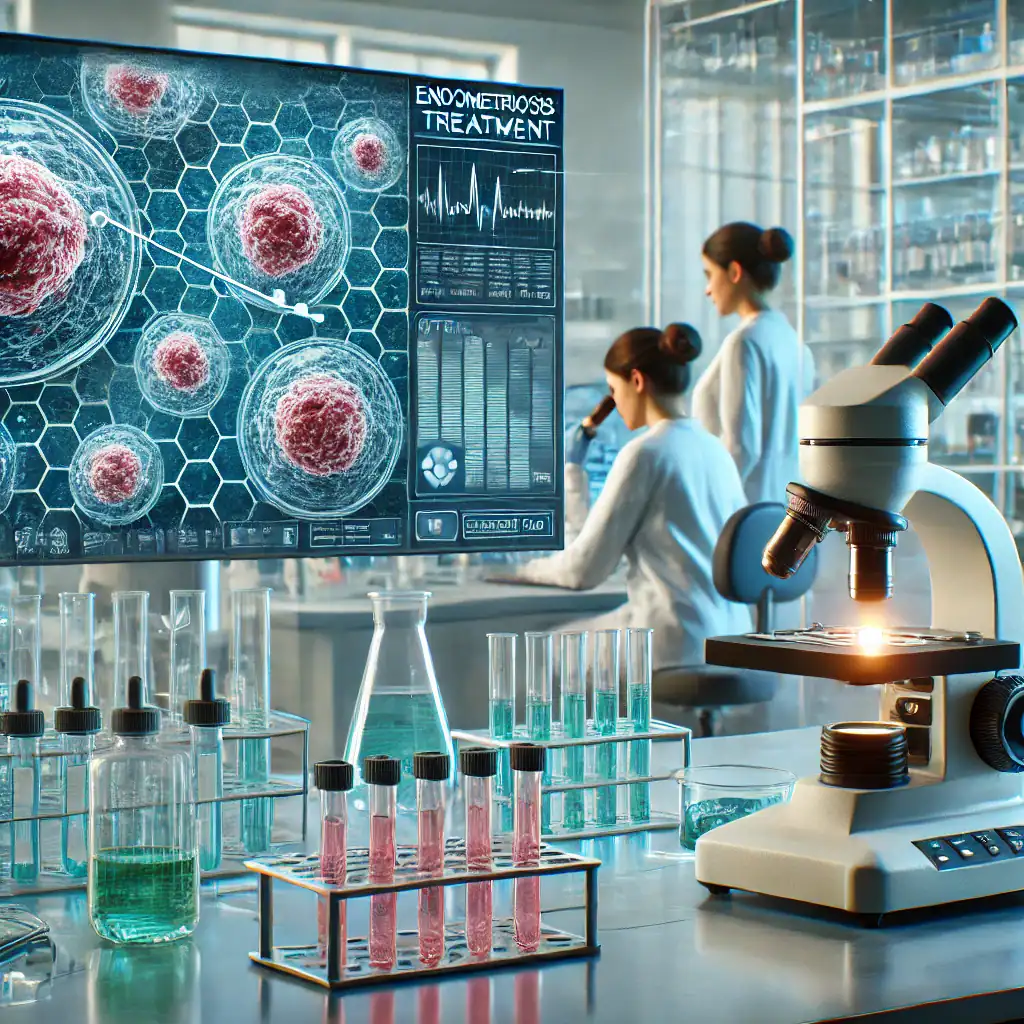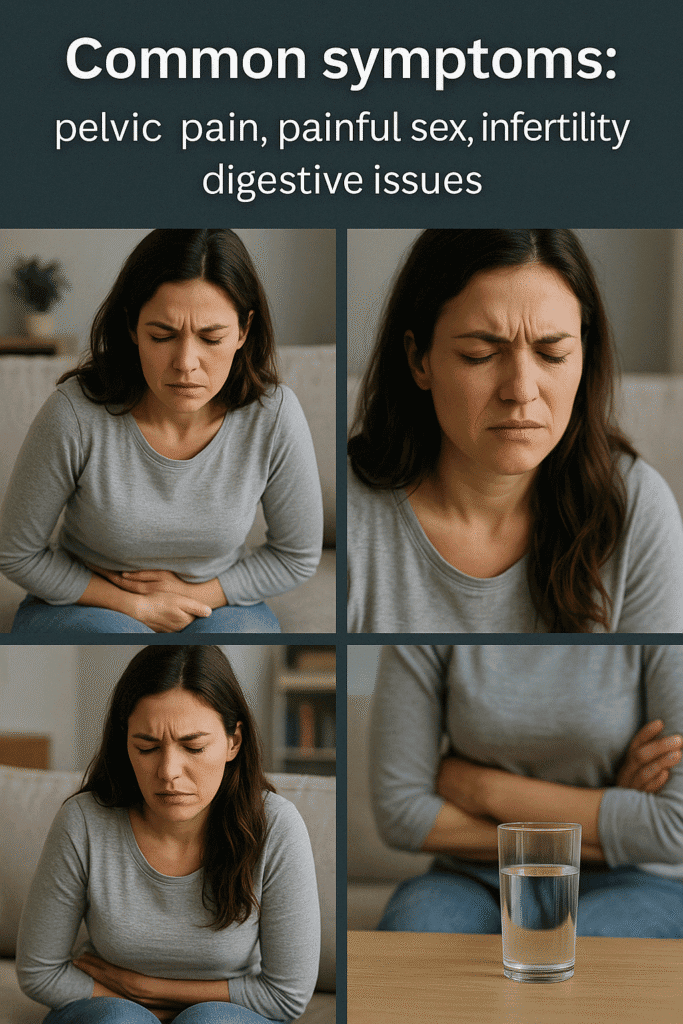
Stem Cell Therapy for Endometriosis – Introduction
Endometriosis is a painful and often debilitating inflammatory condition that affects approximately 1 in 10 women during their reproductive years. It occurs when tissue similar to the lining of the uterus grows outside the uterus—on the ovaries, fallopian tubes, or other pelvic organs—causing chronic pain, heavy menstrual bleeding, infertility, and deep fatigue. The physical symptoms are only part of the struggle; the emotional and psychological toll can be just as overwhelming.
Traditional treatments, such as hormone therapy and surgical interventions, can offer temporary relief. However, they often come with unpleasant side effects like mood swings, bone loss, or early menopause—and in many cases, the symptoms eventually return. This cycle of recurring pain and frustration leads many women to feel hopeless, dismissed, or trapped in a system that doesn’t provide lasting solutions.
This leaves many women asking: Is there a better way? Can modern science offer something more than just symptom control?
Emerging research suggests that stem cell therapy for endometriosis may hold new hope. Unlike traditional approaches, stem cell-based treatments aim to regenerate damaged tissues, reduce inflammation at its root, and potentially restore reproductive function. For women who have tried everything without success, this innovative therapy could represent the breakthrough they’ve been waiting for.
Stem Cell Therapy for Endometriosis – The Body’s Natural Repair Kit
Stem cells are powerful, adaptable building blocks of the human body. They have the extraordinary ability to develop into various types of tissue—such as muscle, nerve, or endometrial tissue—and play a crucial role in regeneration and repair. In recent years, their medical potential has become one of the most exciting frontiers in science. For conditions that involve chronic inflammation and cellular damage, like endometriosis, stem cells offer something groundbreaking: not just symptom relief, but true biological healing.
In the context of stem cell therapy for endometriosis, these versatile cells present a novel and potentially transformative option. Unlike traditional treatments that merely suppress symptoms with hormones or surgically remove lesions, stem cell therapy targets the disease at its core. It aims to repair damaged tissue, rebalance the immune response, and promote a healthier pelvic environment.
Researchers around the world are now studying how stem cell therapy for endometriosis might work in real-world settings. Current studies suggest that stem cells could:
- Regulate immune system dysfunction, a key driver of endometrial tissue growth outside the uterus
- Decrease chronic pelvic inflammation, which causes ongoing pain and tissue scarring
- Reverse damage to reproductive organs, potentially improving overall pelvic health
- Support the restoration of fertility in women who struggle to conceive due to endometriosis-related complications
While more clinical trials are needed, early findings offer new hope for a more permanent, regenerative solution to this deeply disruptive condition.
Stem Cell Therapy for Endometriosis – Origins of Endometriosis: Friend or Foe?
Interestingly, some types of stem cells may also play a surprising role in the development of endometriosis. Emerging studies suggest that menstrual blood-derived and bone marrow-derived stem cells could be involved in creating the very abnormal tissue that defines the disease. These so-called “rogue” stem cells may escape the uterine lining during menstruation, a process known as retrograde menstruation, and then implant themselves on organs outside the uterus—such as the ovaries, fallopian tubes, or pelvic wall. This is especially likely in women who already have underlying immune or hormonal imbalances that prevent the body from clearing misplaced cells properly.
This discovery offers new insights into how deeply interconnected the immune system, hormonal regulation, and cellular repair mechanisms are in the pathophysiology of endometriosis. Understanding that stem cells may contribute to the disease also raises a critical question: can we harness these same cells for healing instead of harm?
Here’s the silver lining: if stem cells are part of the problem, could they also be part of the solution? Researchers believe the answer might be yes. With stem cell therapy for endometriosis, scientists are now exploring how to redirect the regenerative power of stem cells in a therapeutic way—helping the body rebuild healthy tissue, modulate the immune system, and stop abnormal cell growth. This concept opens the door to highly personalized treatments that use the body’s own healing mechanisms to fight the disease from within.
Rather than viewing stem cells only as a cause of disease, this evolving field encourages us to consider them as powerful agents of recovery—especially in the context of stem cell therapy for endometriosis.
Stem Cell Therapy for Endometriosis – How Stem Cell Therapy Could Work
There are two primary categories of stem cells currently being investigated for their potential use in stem cell therapy for endometriosis. Each type offers unique advantages and mechanisms for healing that could one day revolutionize treatment.
1. Mesenchymal Stem Cells (MSCs)
Mesenchymal stem cells are multipotent cells typically harvested from bone marrow, adipose (fat) tissue, or even menstrual blood. MSCs have powerful anti-inflammatory properties and are capable of regenerating damaged tissues. In the context of stem cell therapy for endometriosis, these cells offer several promising benefits.
Researchers have found that MSCs may:
- Suppress excessive estrogen activity in endometrial lesions, which can slow their growth
- Reduce immune system overreaction, a key trigger for inflammation and tissue invasion
- Inhibit angiogenesis—the growth of new blood vessels that feed abnormal endometrial tissue
- Promote the regeneration of healthy endometrial and pelvic tissue, supporting long-term healing
What makes MSCs particularly valuable is their ability to migrate to inflamed or damaged areas, release healing signals, and modify the local immune environment. This aligns perfectly with the goal of stem cell therapy for endometriosis: to treat the root causes rather than just the symptoms.
2. Menstrual Stem Cells (MenSCs)
Menstrual stem cells, found in the blood shed during menstruation, are another exciting option. These cells are easy to collect, ethically sourced, and naturally regenerative. Because they originate from the endometrium itself, MenSCs are biologically well-suited for addressing conditions like endometriosis.
Studies suggest that MenSCs may hold the ability to:
- Rebuild damaged endometrial tissue with fewer side effects
- Deliver targeted immune modulation with greater precision
- Serve as a safer, patient-specific cell source for regenerative therapy
In many ways, MenSCs represent the future of stem cell therapy for endometriosis—offering a less invasive, highly accessible solution that harnesses the body’s own potential to heal.
Stem Cell Therapy for Endometriosis – Behind the Scenes: What the Science Shows So Far
Recent studies have shed light on how stem cell therapy for endometriosis could become a revolutionary approach to treating the disease—not just by relieving symptoms, but by transforming the way we understand and heal it. In animal models, mesenchymal stem cells (MSCs) have demonstrated a remarkable ability to reduce the size of endometrial lesions and decrease pain-related behaviors. This offers hope for millions of women who struggle daily with chronic pelvic pain, fatigue, and infertility.
Meanwhile, menstrual stem cells (MenSCs) have shown unique immune-modulating capabilities. Research indicates that MenSCs can actively reduce inflammation and even reverse fibrosis—the internal scarring that often worsens pain and damages reproductive organs. These results suggest that stem cell therapy for endometriosis may not only prevent the progression of the disease but also help undo years of internal damage caused by repeated flare-ups.
One of the most exciting discoveries in this field involves extracellular vesicles—tiny biological packages released by stem cells. These vesicles carry potent healing signals, including proteins, microRNAs, and growth factors, which can reprogram inflamed or damaged tissue and calm overactive immune responses. Scientists believe that these vesicles may one day serve as a stand-alone, cell-free treatment, offering the benefits of stem cell therapy for endometriosis without requiring direct cell transplantation.
In short, stem cells don’t just manage symptoms; they hold the potential to reset the immune system, repair scarred tissues, and halt the disease at its source. For women who have long felt ignored or underserved by traditional treatments, these findings represent a powerful new chapter in the search for healing and hope.
Stem Cell Therapy for Endometriosis – Are Human Trials Underway?
Yes—but this exciting area of research is still in its early stages. Several clinical trials are currently being conducted to assess the safety, tolerability, and long-term effectiveness of mesenchymal stem cells (MSCs) in women suffering from endometriosis-related pain, inflammation, and infertility. These studies are primarily focused on how MSCs interact with the immune system, reduce inflammation, and repair damaged pelvic tissues. While most results so far come from animal models, early human data is beginning to show signs of real promise.
Researchers across the globe—particularly in Europe, the United States, and parts of Asia—are working to understand how stem cell therapy for endometriosis can be delivered safely, whether through direct cell injections, intravenous infusions, or via extracellular vesicles released by the cells. Some small trials have already demonstrated improvements in pain levels and quality of life, without serious side effects. However, most of these studies are in Phase I or II, which means larger trials are needed to confirm both safety and efficacy before this therapy can become widely accessible.
The progress is encouraging, but experts caution that we’re not quite at the finish line. Regulatory approval takes time, and researchers must ensure that any future treatment is both effective and affordable. Still, the momentum is growing. For women who have tried every conventional treatment with little success, the idea that stem cell therapy for endometriosis could one day offer long-term relief—without surgery or hormones—is both powerful and deeply hopeful.
Stem Cell Therapy for Endometriosis – Potential Benefits
If current clinical trials prove successful, stem cell therapy for endometriosis could dramatically reshape how this chronic condition is treated. Unlike traditional options that often provide only short-term relief or come with significant side effects, stem cell-based approaches aim to offer more permanent and regenerative solutions. This could mark a turning point for women who have endured years of hormonal treatments, painkillers, and repeated surgeries—often with limited success.
Some of the most exciting potential benefits include:
- Long-lasting pain relief: Instead of masking symptoms temporarily, stem cells may help address the root causes of chronic pelvic pain by calming inflammation, healing damaged tissue, and balancing immune function.
- Fewer hormone-related side effects: Current therapies often rely on medications that disrupt natural hormonal cycles, leading to mood swings, hot flashes, and even bone loss. Stem cell therapy for endometriosis may allow women to avoid these risks entirely.
- Reduced need for surgery: Surgical removal of lesions is often repeated every few years, especially when the disease returns. If stem cells can promote tissue repair and suppress regrowth, the need for invasive procedures could decrease significantly.
- Lower recurrence rates: One of the biggest frustrations with endometriosis is how often it comes back. Stem cells may help change that by restoring balance at the cellular and immune level, potentially keeping symptoms from returning.
- Fertility support: Perhaps most importantly for many women, stem cell therapy may help improve fertility by healing damage to the ovaries, uterus, and fallopian tubes—offering hope for natural conception without needing aggressive fertility treatments.
If these benefits are confirmed through future studies, stem cell therapy for endometriosis could become not just an alternative—but the new standard of care.
Stem Cell Therapy for Endometriosis – Risks and Considerations
While the potential of stem cell therapy for endometriosis is exciting, it’s important to approach this emerging treatment with a realistic understanding of its current limitations and risks. Like any medical breakthrough in development, stem cell therapy is not yet a guaranteed solution—and it’s certainly not without challenges.
Here’s what patients and providers need to consider:
- It’s still experimental: At this stage, stem cell therapy for endometriosis remains in the research phase. It has not yet received FDA approval for this specific use, which means it’s only available through clinical trials or private clinics—some of which may operate without strict regulation.
- Possible risks exist: Although stem cells are often promoted as safe and natural, there are still potential complications. These include immune responses (especially when using donor cells), and in rare cases, unwanted tissue growth or misdirected regeneration. Long-term effects need further study.
- High costs and limited access: Because it is not an approved mainstream treatment, stem cell therapy is rarely covered by insurance. Out-of-pocket costs can be significant, placing this option out of reach for many women who might otherwise benefit from it.
- Insufficient long-term data: The current clinical evidence is promising, but still limited. Researchers need more time to observe how patients respond over years—not just months—to fully understand the safety, durability, and effectiveness of stem cell therapy for endometriosis.
In summary, while this therapy offers new hope, it’s essential to balance optimism with caution. Women considering this route should consult with experts, explore only reputable research centers, and stay informed as the science evolves. Stem cell therapy for endometriosis could change lives—but we must let the evidence lead the way.
Stem Cell Therapy for Endometriosis – What’s Coming Next in Stem Cell Research?
Scientists around the world are working tirelessly to make stem cell therapy for endometriosis not only safer and more effective but also more accessible to the women who need it most. As understanding deepens and technology advances, researchers are fine-tuning how stem cells are collected, processed, and delivered to target tissues with greater precision.
This growing body of research is focused on minimizing potential risks while maximizing long-term healing benefits. From exploring cell-free alternatives like extracellular vesicles to developing personalized treatment plans based on a patient’s unique hormonal and immune profile, the future of stem cell therapy for endometriosis is filled with innovation and possibility.
Here’s what’s currently in the pipeline:
- Smarter Delivery: Researchers are finding ways to guide stem cells directly to where they’re needed in the body—like using a GPS system.
- Gene Editing for Safety: Tools like CRISPR are being used to “fine-tune” stem cells so they behave exactly as intended and avoid unwanted side effects.
- Powerful Cell Messengers: Instead of using whole stem cells, doctors may use tiny bubbles called extracellular vesicles (EVs) that carry healing signals between cells.
- Exosome Therapy: These are like mini-packages sent by stem cells, full of helpful proteins and messages. They might offer non-invasive treatment options in the future.
In simple terms, researchers like Kong and Chu are exploring how cells “talk” to each other—and how we can use that communication to heal the body more gently and precisely.
Stem Cell Therapy for Endometriosis – Final Thoughts: Hope Is on the Horizon
Stem cell therapy isn’t a miracle cure—yet—but it represents the most promising shift in decades for treating endometriosis. Rather than relying on hormones or repeated surgeries, regenerative medicine may soon offer a new path: one that restores, rather than removes.
If you or someone you love is navigating life with endometriosis, keep a close eye on this evolving science. The future looks hopeful—and healing may be just around the corner.
References
- Artemova, D., et al. (2023). The prospects of cell therapy for endometriosis. Journal of Assisted Reproduction and Genetics, 40, 955–967.
- Chu, X., et al. (2024). Extracellular vesicles in endometriosis: role and potential. Frontiers in Endocrinology, 15, 1365327.
- Kong, Y., et al. (2021). Endometrial stem/progenitor cells and their roles in immunity, clinical application, and endometriosis. Stem Cell Research & Therapy, 12, 474.
- Garvey, M. (2024). Future Biological Perspectives for Diagnosis and Treatment of Endometriosis. International Journal of Molecular Sciences, 25(22), 12242.
- Ochoa Bernal, M.A., & Fazleabas, A.T. (2024). The Known, the Unknown and the Future of the Pathophysiology of Endometriosis. International Journal of Molecular Sciences, 25(11), 5815.











